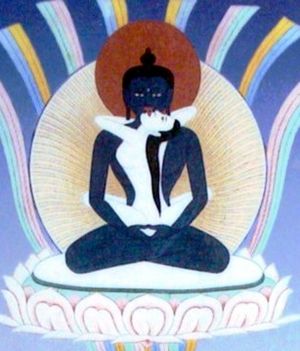Dharmakaya: Difference between revisions
Jump to navigation
Jump to search
mNo edit summary |
No edit summary |
||
| Line 1: | Line 1: | ||
'''Dharmakaya''' (Skt. ''dharmakāya''; Tib. ''chö ku''; [[Wyl.]] ''chos sku'') — ‘the Absolute or Truth [[kaya|Body]]’. Upon the attainment of [[buddhahood]], [[enlightenment]] manifests at three levels, which are known as the three bodies of the [[Buddha]]: the Absolute or Truth Body, or dharmakaya; the Enjoyment Body, or [[sambhogakaya]]; and the Emanation Body, or [[nirmanakaya]]. | [[Image:Samantabhadra.jpg|thumb|The Dharmakaya Buddha [[Samantabhadra]]]]'''Dharmakaya''' (Skt. ''dharmakāya''; Tib. ''chö ku''; [[Wyl.]] ''chos sku'') — ‘the Absolute or Truth [[kaya|Body]]’. Upon the attainment of [[buddhahood]], [[enlightenment]] manifests at three levels, which are known as the three bodies of the [[Buddha]]: the Absolute or Truth Body, or dharmakaya; the Enjoyment Body, or [[sambhogakaya]]; and the Emanation Body, or [[nirmanakaya]]. | ||
[[Sogyal Rinpoche]] writes: | [[Sogyal Rinpoche]] writes: | ||
Revision as of 10:00, 20 July 2009

Dharmakaya (Skt. dharmakāya; Tib. chö ku; Wyl. chos sku) — ‘the Absolute or Truth Body’. Upon the attainment of buddhahood, enlightenment manifests at three levels, which are known as the three bodies of the Buddha: the Absolute or Truth Body, or dharmakaya; the Enjoyment Body, or sambhogakaya; and the Emanation Body, or nirmanakaya.
Sogyal Rinpoche writes:
- Absolute nature is the dharmakaya, the ‘empty’, unconditioned truth, into which illusion and ignorance, and any kind of concept, have never entered. (The Tibetan Book of Living and Dying, page 347.)
'Dharmakaya' is also the eighth of the eight topics of the Abhisamayalankara. See Resultant Dharmakaya.